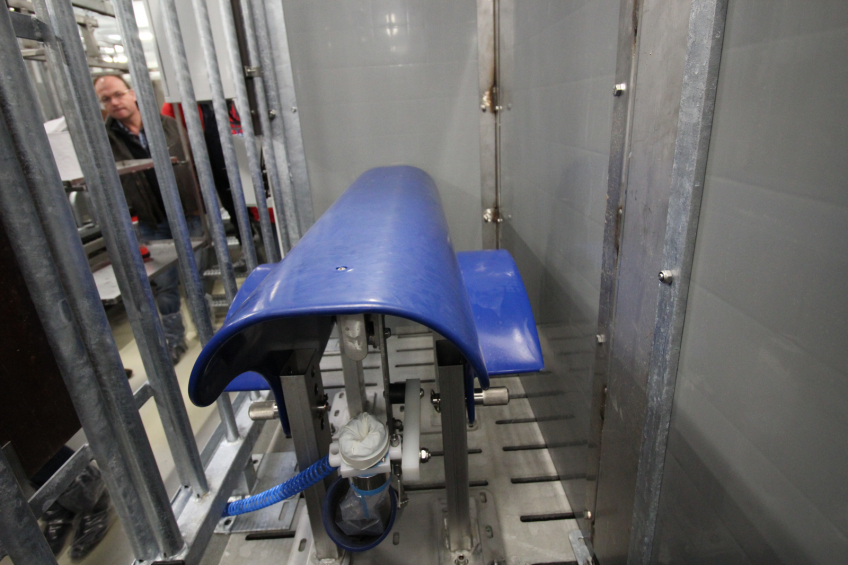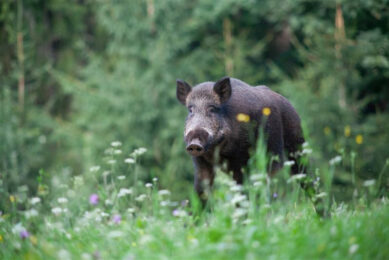New boar stud benefits from high hygiene standards

With modern knowledge and techniques, it is possible to keep diseases out. Hence artificial insemination cooperative Cobiporc considered the time is right to open a large and efficient new boar stud for 300 male animals. Pig Progress had a sneak ?preview.
By Vincent ter Beek
The only females at the newest pig farm in Janzé are to be found in the laboratory, analysing and testing semen. All the other inhabitants of the facility are male. The new stud, developed and owned by French cooperative Cobiporc and taken into use in February 2015, houses in total 300 boars and is ready for the future.
Cobiporc is an artificial insemination (AI) cooperative headquartered in the heart of Brittany, France. The cooperative has 1,800 pork producing customers in Brittany and its neighbouring regions of Lower Normandy and Pays de la Loire. The organisation holds about 60% of the total AI market in the west of France, and about 40% in the whole of France. Its genetics are 80% Piétrain or Duroc-Piétrain, animals with a generally low fat rate.
Jean-Yves Trelhu, president of Cobiporc, dives into history, explaining: “In the past we used to think that spreading our risk was the best we could do with regard to building boar studs. This meant that we had many, and small, boar studs. After all, if a disease would break out, it would only affect that population – but the others would live.”
That was thirty years ago. Times have changed, a lot of knowledge about diseases has been gathered and thinking about biosecurity has moved on. Trelhu continued, “Nowadays, we know so much about hygiene that it is safe to put 300 animals in one facility without any risk. Now we can benefit from the fact that we have much more in the same place and reach higher efficiency.”
The new boar stud replaces three other sites, which together had about 350 boars. The farm is U-shaped, see Figure 1. On the left and on the right side are the boar quarters, with 15 rooms of 20 pens, one pen per boar of 2×3 metres, equipped with solid feeding systems, central ventilation and geothermal heating. In the middle, centrally located, is the collection area – with an adjacent laboratory.
Biosecurity
Several elements can be a source of contamination – air, animals, people and equipment – and for each a large protocol has been set up in order to avoid exactly that.
A modern filtration system has been applied to filter all incoming air. Particles of very small size will be caught so that the particles cannot enter the farm. “We filter out 99.5% of everything that comes in,” explains Trelhu. Inside the farm building there is an underpressure, so automatically all air is drawn in through the filters.
Interestingly, a good air quality inside the building contributes to a better hygiene and health status of the boar stud. One of the aspects of better air quality starts underneath the pig house – in the manure pens, as the goal is to get urine and faeces out as quickly and efficiently as possible. Inside the barns this happens by manually moving about 2 kg of daily faeces per boar into a separate hole in the corner of each pen. Underneath the pen, the slurry pit has two slopes. Across the breadth of the room, slopes of the slurry pit rises by 10% to either side from the middle; across the length of the room the slurry pit slopes up by 1.5% all the way up to the end. This ensures all urine to flow gently towards a central collection point underneath the farm. At the same time, underneath the floor, there is also an automatic scraping device, supplied by French pig cooperative Cooperl, that will push any faeces of the boars once a day in the opposite direction of the urine – up the slope of 1.5%. This way a daily separation of solid and liquid manure is ensured. The solid manure can be used as fertiliser, the liquid manure can directly be applied on the land, and the air inside the pig house is relatively clean.
The pigs are being continuously tested for their health quality. Upon entrance, they go into a seven-week quarantine and all their blood values are tested. In addition, every week one-fifth of all the boars get their blood tested as well, this means that in about three months the Cobiporc team has checked the entire boar population for diseases – this includes Aujeszky’s Disease (pseudorabies), brucellosis, PRRS and swine influenza.
People are required to shower upon entrance and wear specific clothes for this farm. There is a different shower sluice for the laboratory staff and the boar caretakers.
Not only inside is biosecurity a hot issue – outside the boar stud the biosecurity protocol goes further. After quality control checking (more about that later), the packed semen is picked up by the same dedicated van, which does nothing else but bring the semen from this facility to the central distribution building of Cobiporc near Rennes, the capital of Brittany, about 30 km down the road. In this place, all semen from all other stations are also combined, after which the right packaging can follow and further distribution to pig breeders follows. The van is the only transport vehicle that is allowed to enter the boar stud’s
premises.
Efficiency
With the new farm’s hygiene stepped up so much, there is no longer an objection to having many boars on one site. Economy of scale works here, but in addition, much in the farm’s lay-out and in its equipment help the boar stud to do more with fewer people. A simple example is that of aisle design – they have a width of 80 cm. Wide enough for a boar to pass through, but not wide enough to make him for instance turn around and go back. The temptation to stop at every other pen has also been taken away, as door openings to each pen have been completely closed so there is nothing to see for any boar in the aisle. Result – boars move quicker in the direction they should go.
In total, about six people can do the work that used to be done by at least ten. In the central collection zone, two permanent staff are sufficient to ‘collect’ the boars. They work in a small alley with in total five pens on either side equipped with dummy sows. Boars are brought in from the left or the right side of the building, by the other staff members. The collection pens are equipped with ‘warming pens’, where boars get themselves excited while waiting for their turn. Once the door opens, the boar will mount the dummy. For staff members it is just a relatively quick job to wait for the first – highly contaminated – ejaculate to drop on the floor, after which the semen collector is connected to the boar’s penis. For this purpose, five copies of the ‘Collectis’ are being used – a device by IMV Technologies, made up of an artificial vagina, which can automatically widen and loosen up in order to stimulate the boar’s penis. The device also contains a filter. At the other end of the Collectis, a plastic bag is connected, which will catch the filtrated ejaculate, avoiding human interference or bacterial contamination. Once the boar has done his business, he usually automatically retracts and lies down in a corner of the pen. Staff can then easily take the bag, seal it, scan the boar’s ear tag and print a sticker with the relevant bar code. Thus the labelled semen is put into a pneumatic tube system and arrives safely in the laboratory.
Laboratory
At the other side of the system, staff will analyse the ejaculate samples. First, the semen has to be tested whether it matches the quality requirements as set by Cobiporc. This is performed with the Ivos II, Casa, from Hamilton Thorne, which can simultaneously analyse as well as record obtained data. Elements checked include e.g. the morphology (what is the shape of the semen cells?), their motility (how do they move?) and sperm cell concentration. All production data are recorded into eSmile, specific AI centre management software, guaranteeing traceability. Once all is approved, the computer will start a dilution programme. With Cobiporc’s own extenders Kobidil+ and D-Max 6, the semen gets diluted so that one ejaculate provides enough for on average 30 bags – again sufficient for 30 artificial insemination sessions on-farm. In this way, although being completely absent, sows are on the mind of each and every individual, both porcine and human. PP
Cobiporc boar stud, Janzé, France
Capacity: 300 boars
Breeds: Piétrain/ Duroc-Piétrain
Annual output: 530,000 doses
Filling machine
Filling semen into bags happens with a machine called GTB 100 V3, which is supplied by French artificial insemination equipment company IMV Technologies, owner of also the Collectis and the eSmile software. The GTB machine was developed in 2009, improved in 2010 and the third generation appeared on the market in 2014, explains Benoît Bouvier, sales director for Europe, Middle East and Africa. Only consisting of composite material, and not having sharp edges, the filling machine is easy to clean and maintain. In addition, the semen can be filled in regular bags of 80 ml, but can also be filled in smaller portions of 40 ml, destined for breeding farms using intra-uterine (deep) insemination.











